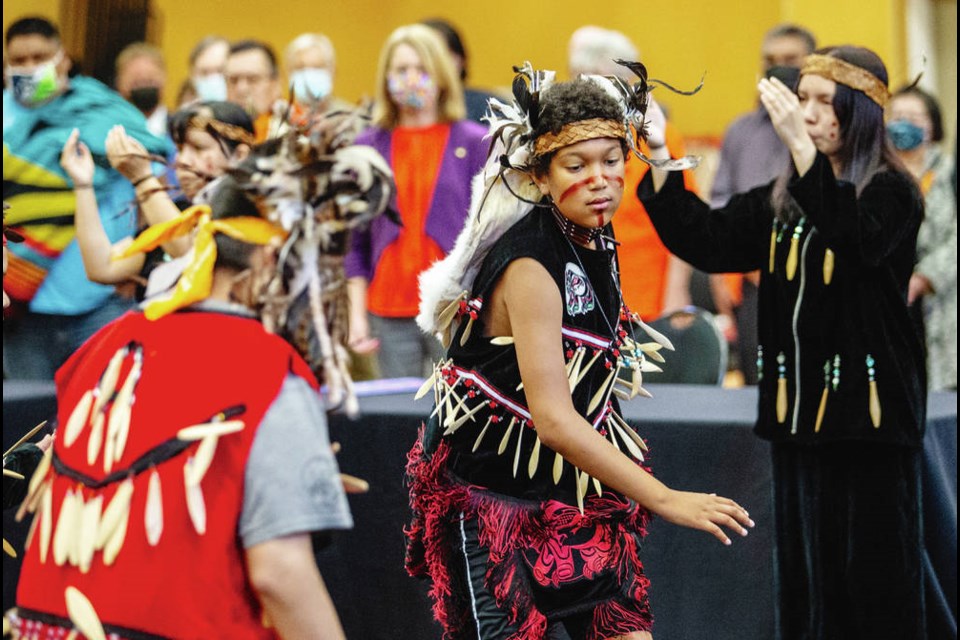Island First Nations chiefs issued a statement Friday calling for an end to vandalism and violence, and one nation said it has hired 24/7 security to protect its longhouse and totem poles. The move by the Songhees First Nation came after the toppling of the Capt. James Cook statue at the Inner Harbour last week provoked online threats of retaliation against First Nations communities, the nation’s chief said.
The Songhees were not involved in knocking down the statue, but they’re bearing the brunt of people’s frustration with the vandalism, said Chief Ron Sam, adding members are facing racism while out grocery shopping, driving or walking in their neighbourhood.
“Right now, a lot of people don’t feel safe going out alone,” he said.
Since the nation hired security on Sunday, people have been chased away from its longhouse and totems in 11 incidents, sometimes late at night, Sam said.
Threats have surfaced online since Canada Day, when a group knocked down the Cook statue and threw it into the Inner Harbour.
Hours later, a totem pole at the Malahat viewpoint was set on fire with a message suggesting it was in retaliation for the toppled statue. Vandalism at an Esquimalt church has prompted threats against longhouses, Sam said.
Sam was among chiefs representing First Nations across the South Island who came together Friday at the Songhees Wellness Centre to denounce the recent acts of vandalism and call on communities to work together for a safer community.
“We are leaders of the South Island Indigenous communities and these acts are not ours, we do not support them, and we do not believe in dividing communities,” they said in a joint statement prepared by chiefs of the Songhees Nation, Esquimalt Nation, Beecher Bay First Nation, T’Sou-ke Nation, Malahat First Nation, Tsawout First Nation, Tsartlip First Nation, Pauquachin First Nation and Tseycum First Nation.
The First Nations leaders were joined by politicians at the municipal, regional, provincial and federal level, who were asked to bring the message from the chiefs back to their communities.
The chiefs said in their statement they felt the need to step in before further destruction.
“These acts are not medicine, they fuel hate and inhibit the healing that is so deeply needed right now. The disrespectful and damaging acts we have seen are not helping. They are perpetuating hurt, hate and divide,” the joint statement said.
Sam said he’s not surprised the Cook statue came down the way it did. He recognized it was a potential target as rallies were organized in response to the discovery of unmarked graves near former residential schools, and raised his concern about a month ago with the Greater Victoria Harbour Authority, which owns the statue.
The statue was due to be discussed at an upcoming meeting of the harbour authority’s First Nations economic development committee. “It just doesn’t happen fast enough for some people,” said Sam, who would ultimately like to see the Cook statue removed.
The harbour authority pulled the statue from the water, but it has not been reinstalled.
Victoria Mayor Lisa Helps, one of many local politicians who attended the ceremony Friday, said it was a powerful moment to have nearly all mayors and chiefs in the region standing together. Helps said she hasn’t commented publicly on the statue because she was following the direction of the local nations.
“Sometimes the best thing we can do as leaders who aren’t Indigenous, when there were Indigenous issues coming up, is stand back, stay out of the fray, and listen and watch and learn from the chiefs,” she said.
Chief Allan Tom of the Pauquachin First Nation said he hopes Friday’s event will be the first of many gatherings for local leaders to get to know each other on a more personal level, “not only when bad things happen.”



